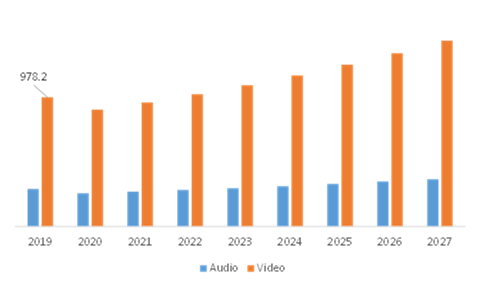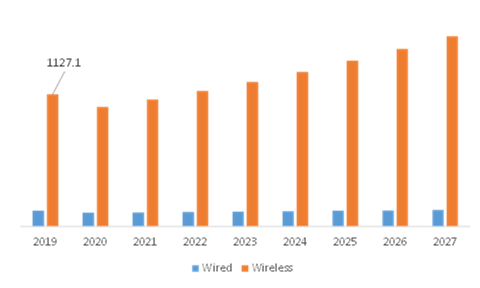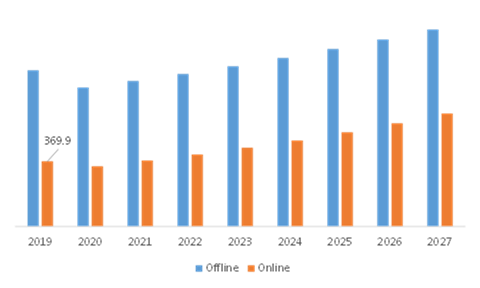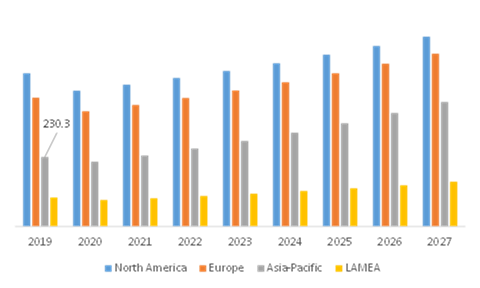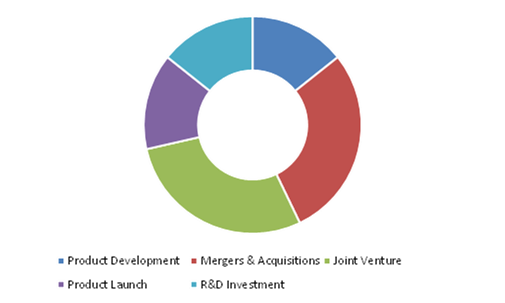Baby Monitor Market Report
RA08357
Baby Monitor Market by Product Type (Audio and Video), Connectivity (Wired and Wireless), Sales Channel (Online and Offline), and Regional Analysis (North America, Europe, Asia-Pacific, and LAMEA): Global Opportunity Analysis and Industry Forecast, 2020–2027
Global Baby Monitor Market Analysis
The global baby monitor market is expected to garner $1,761.7 million in the 2020–2027 timeframe, increasing from $1,258.5 million in 2019 at a noteworthy CAGR of 6.5%.
Market Synopsis
Significant increase in the number of working parents combined with the extensively rising awareness about newborns’ death and illnesses is anticipated to fuel the growth of the global baby monitor market.
However, innovative baby monitors are expensive, which may restrict the market growth.
According to the regional analysis of the baby monitor market, the Asia-Pacific market is expected to surge at a CAGR of 9.8% by registering a revenue of $412.2 million, throughout the analysis period.
Baby Monitor Overview
A baby monitor is an electronic device that parents use to efficiently and constantly monitor the movements and sounds of their babies. The device is a sort of an alarm system which helps in detecting baby’s activities and conveying messages regarding the condition of the baby to the concerned guardian via a Wi-Fi or wired connectivity platform. In the modern era, when the parents are busy with their career, a baby monitoring system can be a crucial solution for handling babies properly instead of appointing a nanny for them or keeping them in an infant day care center.
Impact Analysis of COVID-19 on the Global Baby Monitor Market
The COVID-19 outbreak has brought unprecedented challenges to most of the world's businesses. The baby monitor market also witnessed negative impact throughout the period. On the other hand, leading baby monitor companies like Philips, Vacos, and Miku came up with multiple strategies like product development, collaborations, and research & developments. For instance, in April 2020, Miku, top-rated infant monitoring system providers announced to install its award-winning monitors ‘contact-free baby monitors’ in the healthcare facilities across the U.S. with multiple establishments planned amidst the COVID-19 crisis. Also, in February 2021, Vacos, a notable player in baby monitoring market, officially launched its 1st hackproof Baby Monitor, during the COVID-19 outbreak. The baby monitor offers parents the ‘all-in-one intelligent way’ to keep a tab on their new-born at home remotely. Such company developments and social initiatives may drive the global baby monitor market, post COVID-19 pandemic.
Growing Women's Participation in the Workforce to Upsurge the Market Growth
Women's participation in the workforce particularly in the U.K. and the U S. has witnessed a massive growth in the past years. For instance, according to a survey conducted by Office for National Statistics (ONS), UK's largest independent producer of official statistics, the number of working women was found to have increased to a record high, as nearly 75% of them had jobs in 2019. Moreover, approximately 66.2% of mothers were employed in 2000. Furthermore, that figure increased to 75.1% by the end of 2019. As per the American Community Survey, a survey program conducted by the U.S. Census Bureau, there were around 23.5 million employed women in the U.S. and among them approximately two-thirds of the working women worked full-time. The above-mentioned figures showcase that the demand for innovative baby care products is expected to increase, which may eventually drive the global monitor market.
To know more about global baby monitor market drivers, get in touch with our analysts here.
High Cost of Installing Baby Monitors to Restrain the Market Growth
The high cost of baby monitoring systems (around $150-250 per piece) is projected to restrain the growth of the global baby monitor market. Also, digital baby monitors create an electromagnetic field (EMF) which may cause side-effects including sleep cycle disruption, impact on brain development, and others. Such factors can create a negative impact on the market.
Introduction of Zero-Radiation Baby Monitoring System to Create Investment Opportunities
Baby monitoring systems are becoming vital for new parents in the modern age. But the use of baby monitoring systems may cause potential hazards namely, developmental disorders and cancer on the new-born babies as children absorb over 60% more radiation than adults from the surroundings. Hence, market leaders like Bebcare Baby Care., world's lowest emission digital baby monitor provider, are coming up with novel products. Bebcare Baby Care provides a unique DSR (Digital Safe Radio) technology which is one of the safest baby monitoring systems, across the industry. Furthermore, the Bebcare’s DSR technology significantly decreases wireless radiation by nearly 90% compared to other baby monitoring systems. Such novel innovations may create favorable conditions in the global baby monitor market during the forecast period.
To know more about global baby monitor market opportunities, get in touch with our analysts here.
Global Baby Monitor Market, by Product Type
Based on product type, the market has been divided into audio and video sub-segments of which the video sub-segment is anticipated to experience the fastest growth and hold the most dominant market share.
Source: Research Dive Analysis
The video baby monitor sub-segment is expected to have the largest share in the global market and is anticipated to generate a revenue of $1,405.3 million, during the forecast period. The video baby monitors play a crucial role in gathering round-the-clock data on the newborn and alerts the parents when they detect signs of distress such as vomiting and crying. Hence, the demand for video baby monitors has predominantly increased from the millennial parents, which is fueling the market growth. Also, increasing disposable incomes and greater financial stability across developing countries such as China, India, and Brazil may foster the demand for the baby monitoring system in these regions. Owing to the increasing need for baby monitors, a high-quality baby monitor provider, Infant Optics, officially launched its new ‘DXR-8 PRO video baby monitor’ in November 2020. This latest product addition has several offerings like high-quality video, improved range in its compact, patent-pending active noise reduction (ANR) technology, and sleek design.
Global Baby Monitor Market, by Connectivity Type
On the basis of connectivity, the market has been sub-segmented into wired and wireless. Among the mentioned sub-segments, the wireless sub-segment will be the most dominant and is further predicted to show the fastest growth, in the coming years.
Source: Research Dive Analysis
The wireless sub-segment of the global baby monitor market is projected to have the fastest growth and it is projected to surpass $1,621.9 million by 2027, with an increase from $1,127.1 million in 2019. Wireless (Wi-Fi) baby monitors connect to existing internet networks and can be controlled by any smart device including mobiles, laptops, and desktops. These baby monitors include both video and audio capabilities. Moreover, key features include voice assistants, real-time footage of baby, combined with capability to store video footage via mobile app or cloud storage, which may spur the demand for the wireless monitors, in the coming years. Also, key players namely Motorola (Binatone), Cocoon Cam, and others are offering attractive deals on Wi-Fi baby monitors with 1080p and night vision cameras. Such factors are expected to foster the wireless baby monitor sub-segment in the future.
Global Baby Monitor Market, by Sales Channel:
Based on sales channel, the segment has been bifurcated into online and offline. Out of these, the online sub-segment is predicted to have the fastest growth and offline sub-segment is anticipated to garner the maximum revenue share in the global market.
Source: Research Dive Analysis
The online sub-segment of the global baby monitor market is predicted to have a rapid growth and it is expected to surpass $642.6 million by 2027, with the rise from $369.9 million in 2019 owing to the increasing popularity and acceptance from millennials and busy parents. Also, online sales channel is recognized as a type of highly improved communication channel in the recent years. In addition to this, the channel offers multiple advantages such as streamlined communication, enhanced customer service, less barriers to entry, among others. In addition to this, safe and comfortable shopping, elimination of human error, and easy availability of services are factors that can be the responsible for the rapid growth of online sub-segment, in the forecast period.
The offline sub-segment is predicted to have a dominating market share in the global market and is anticipated to generate a revenue of $1,119.1 million, during the analysis timeframe. Offline channels are highly cost–effective and hence they are potential profit centers of sales. Moreover, offline sales channel is a definite model for additional revenue generation, mainly because it has powerful forces of influence and it provides open opportunities for cross-sell and upsell. Offline distribution channel significantly helps in building engagement with customers of the local market.
Global Baby Monitor Market, Regional Insights:
The baby monitor market was investigated across North America, Europe, Asia-Pacific, and LAMEA.
Source: Research Dive Analysis
The Market for Baby Monitor in North America to be the Most Dominant
The North America baby monitor market accounted $507.2 million in 2019 and is projected to register a revenue of $628.9 million by 2027. The extensive growth of the North America market is mainly driven by the massively increased demand for most advanced baby products from busy parents. Also, as per information of CDC (Centers for Disease Control and Prevention) in the U.S., there are around 3,500 sudden unexpected infant deaths (SUID) reported every year. These numbers showcases that the demand for baby monitoring system is expected to increase as these monitors can prevent SIDS to an extent. In addition to this, strong presence of leading baby monitor manufacturers such as Dorel Industries Inc. and Summer Infant Inc is also positively affecting the North America baby monitor industry.
The Market for Baby Monitor in Asia-Pacific to be the Fastest Growing
The share of Asia-Pacific baby monitor market is anticipated to grow at a CAGR of 9.8% by registering a revenue of $412.2 million by 2027. An ever-growing population along with the growing number of working women particularly in emerging nations like China and India has created huge potential for the Asia-Pacific baby monitor industry. Moreover, startup companies of the baby monitoring system operating in the Asian countries are also coming up with novel product developments which may also fuel the market growth. For example, in September 2020, Hero Electronix, Hero Group's venture into the technology space, announced to introduce ‘Qubo Baby Cam’. This device is India’s 1st Smart Baby Monitor built with a kid-friendly approach. The company introduced this high-tech baby monitor in order to resolve the issues of new parents such as increasing workload along with societal pressure. Such company innovations may further lead to propel the market, in the Asia-Pacific region.
Competitive Scenario in the Global Baby Monitor Market
Product launches and mergers & acquisitions are common strategies followed by major market players.
Source: Research Dive Analysis
Some of the leading baby monitor market players are Dorel Industries Inc., VTech Holdings Ltd., Summer Infant Inc., Anker Technology (UK) Ltd, Samsung Corporation, Koninklijke Philips N.V, Angelcare Monitors Inc., Owlet Baby Care, Nanit, and Bebcare Baby Care.
Porter’s Five Forces Analysis for the Global Baby Monitor Market:
- Bargaining Power of Suppliers: A wide variety of products offered by suppliers is one of the major reasons for the increase in suppliers’ bargaining power.
Hence, the bargaining power suppliers is high. - Bargaining Power of Buyers: Global baby monitor market has less number of customer which increases the negotiation power of customers across the globe. In addition, switching costs in this market is low which is again increases the buyers’ bargaining power.
Hence, the bargaining power of the buyers is moderate. - Threat of New Entrants: Companies entering the baby monitor market are developing innovative baby monitor products like IoT/AI powered monitors to attract clients. Also, these companies are implementing multiple effective strategies such as offering discounts and value propositions.
Hence, the threat of the new entrants is high. - Threat of Substitutes: There is no alternative product for baby monitoring system.
Thus, the threat of substitutes is low. - Competitive Rivalry in the Market: The competitive rivalry among industry leaders is rather intense, especially between the global players including Summer Inc, Dorel Industries and Samsung corporation. These companies are launching their value-added services in the international market and strengthening the footprint worldwide.
Therefore, competitive rivalry in the market is high.
| Aspect | Particulars |
| Historical Market Estimations | 2018-2019 |
| Base Year for Market Estimation | 2019 |
| Forecast Timeline for Market Projection | 2020-2027 |
| Geographical Scope | North America, Europe, Asia-Pacific, LAMEA |
| Segmentation by Product type |
|
| Segmentation by Connectivity |
|
| Segmentation by Sales channel |
|
| Key Companies Profiled |
|
Q1. What is the size of the global baby monitor market?
A. The size of the global baby monitor market was over $1,258.5 million in 2019 and is projected to reach $1,761.7 million by 2027.
Q2. Which are the major companies in the baby monitor market?
A. Dorel Industries Inc., VTech Holdings Ltd., and Summer Infant Inc., are some of the key players in the global baby monitor market.
Q3. Which region, among others, possesses greater investment opportunities in the near future?
A. The Asia-Pacific region possesses great investment opportunities for investors to witness the most promising growth in the future.
Q4. What will be the growth rate of the Asia-Pacific baby monitor market?
A. Asia Pacific baby monitor market is anticipated to grow at 9.8% CAGR during the forecast period.
Q5. What are the strategies opted by the leading players in this market?
A. Technological development and strategic partnerships are the key strategies opted by the operating companies in this market.
Q6. Which companies are investing more on R&D practices?
A. Anker Technology (UK) Ltd, Samsung Corporation, and Koninklijke Philips N.V are investing more on R&D activities for developing new products and technologies.
1.Research Methodology
1.1.Desk Research
1.2.Real time insights and validation
1.3.Forecast model
1.4.Assumptions and forecast parameters
1.4.1.Assumptions
1.4.2.Forecast parameters
1.5.Data sources
1.5.1.Primary
1.5.2.Secondary
2.Executive Summary
2.1.360° summary
2.2.By product type trends
2.3.By connectivity trends
2.4.By sales channel trends
3.Market overview
3.1.Market segmentation & definitions
3.2.Key takeaways
3.2.1.Top investment pockets
3.2.2.Top winning strategies
3.3.Porter’s five forces analysis
3.3.1.Bargaining power of consumers
3.3.2.Bargaining power of suppliers
3.3.3.Threat of new entrants
3.3.4.Threat of substitutes
3.3.5.Competitive rivalry in the market
3.4.Market dynamics
3.4.1.Drivers
3.4.2.Restraints
3.4.3.Opportunities
3.5.Technology landscape
3.6.Regulatory landscape
3.7.Patent landscape
3.8.Pricing overview
3.8.1.By Product Type
3.8.2.By Connectivity
3.8.3.By Sales Channel
3.9.Market value chain analysis
3.9.1.Stress point analysis
3.9.2.Raw material analysis
3.9.3.Manufacturing process
3.9.4.Distribution channel analysis
3.9.5.Operating vendors
3.9.5.1.Raw material suppliers
3.9.5.2.Product manufacturers
3.9.5.3.Product distributors
3.10.Strategic overview
4.Baby monitor Market, by Product Type
4.1.Audio
4.1.1.Market size and forecast, by region, 2019-2027
4.1.2.Comparative market share analysis, 2019 & 2027
4.2.Video
4.2.1.Market size and forecast, by region, 2019-2027
4.2.2.Comparative market share analysis, 2019 & 2027
5.Baby monitor Market, by Connectivity
5.1.Wired
5.1.1.Market size and forecast, by region, 2019-2027
5.1.2.Comparative market share analysis, 2019 & 2027
5.2.Wireless
5.2.1.Market size and forecast, by region, 2019-2027
5.2.2.Comparative market share analysis, 2019 & 2027
6.Baby monitor Market, by Sales Channel
6.1.Online
6.1.1.Market size and forecast, by region, 2019-2027
6.1.2.Comparative market share analysis, 2019 & 2027
6.2.Offline
6.2.1.Market size and forecast, by region, 2019-2027
6.2.2.Comparative market share analysis, 2019 & 2027
7.Baby monitor Market, by Region
7.1.North America
7.1.1.Market size and forecast, by product type, 2019-2027
7.1.2.Market size and forecast, by connectivity, 2019-2027
7.1.3.Market size and forecast, by sales channel, 2019-2027
7.1.4.Market size and forecast, by country, 2019-2027
7.1.5.Comparative market share analysis, 2019 & 2027
7.1.6.U.S.
7.1.6.1.Market size and forecast, by product type, 2019-2027
7.1.6.2.Market size and forecast, by connectivity, 2019-2027
7.1.6.3.Market size and forecast, by sales channel, 2019-2027
7.1.6.4.Comparative market share analysis, 2019 & 2027
7.1.7.Canada
7.1.7.1.Market size and forecast, by product type, 2019-2027
7.1.7.2.Market size and forecast, by connectivity, 2019-2027
7.1.7.3.Market size and forecast, by sales channel, 2019-2027
7.1.7.4.Comparative market share analysis, 2019 & 2027
7.1.8.Mexico
7.1.8.1.Market size and forecast, by product type, 2019-2027
7.1.8.2.Market size and forecast, by connectivity, 2019-2027
7.1.8.3.Market size and forecast, by sales channel, 2019-2027
7.1.8.4.Comparative market share analysis, 2019 & 2027
7.2.Europe
7.2.1.Market size and forecast, by product type, 2019-2027
7.2.2.Market size and forecast, by connectivity, 2019-2027
7.2.3.Market size and forecast, by sales channel, 2019-2027
7.2.4.Market size and forecast, by country, 2019-2027
7.2.5.Comparative market share analysis, 2019 & 2027
7.2.6.Germany
7.2.6.1.Market size and forecast, by product type, 2019-2027
7.2.6.2.Market size and forecast, by connectivity, 2019-2027
7.2.6.3.Market size and forecast, by sales channel, 2019-2027
7.2.6.4.Comparative market share analysis, 2019 & 2027
7.2.7.UK
7.2.7.1.Market size and forecast, by product type, 2019-2027
7.2.7.2.Market size and forecast, by connectivity, 2019-2027
7.2.7.3.Market size and forecast, by sales channel, 2019-2027
7.2.7.4.Comparative market share analysis, 2019 & 2027
7.2.8.France
7.2.8.1.Market size and forecast, by product type, 2019-2027
7.2.8.2.Market size and forecast, by connectivity, 2019-2027
7.2.8.3.Market size and forecast, by sales channel, 2019-2027
7.2.8.4.Comparative market share analysis, 2019 & 2027
7.2.9.Spain
7.2.9.1.Market size and forecast, by product type, 2019-2027
7.2.9.2.Market size and forecast, by connectivity, 2019-2027
7.2.9.3.Market size and forecast, by sales channel, 2019-2027
7.2.9.4.Comparative market share analysis, 2019 & 2027
7.2.10.Italy
7.2.10.1.Market size and forecast, by product type, 2019-2027
7.2.10.2.Market size and forecast, by connectivity, 2019-2027
7.2.10.3.Market size and forecast, by sales channel, 2019-2027
7.2.10.4.Comparative market share analysis, 2019 & 2027
7.2.11.Rest of Europe
7.2.11.1.Market size and forecast, by product type, 2019-2027
7.2.11.2.Market size and forecast, by connectivity, 2019-2027
7.2.11.3.Market size and forecast, by sales channel, 2019-2027
7.2.11.4.Comparative market share analysis, 2019 & 2027
7.3.Asia Pacific
7.3.1.Market size and forecast, by product type, 2019-2027
7.3.2.Market size and forecast, by connectivity, 2019-2027
7.3.3.Market size and forecast, by sales channel, 2019-2027
7.3.4.Market size and forecast, by country, 2019-2027
7.3.5.Comparative market share analysis, 2019 & 2027
7.3.6.China
7.3.6.1.Market size and forecast, by product type, 2019-2027
7.3.6.2.Market size and forecast, by connectivity, 2019-2027
7.3.6.3.Market size and forecast, by sales channel, 2019-2027
7.3.6.4.Comparative market share analysis, 2019 & 2027
7.3.7.India
7.3.7.1.Market size and forecast, by product type, 2019-2027
7.3.7.2.Market size and forecast, by connectivity, 2019-2027
7.3.7.3.Market size and forecast, by sales channel, 2019-2027
7.3.7.4.Comparative market share analysis, 2019 & 2027
7.3.8.Japan
7.3.8.1.Market size and forecast, by product type, 2019-2027
7.3.8.2.Market size and forecast, by connectivity, 2019-2027
7.3.8.3.Market size and forecast, by sales channel, 2019-2027
7.3.8.4.Comparative market share analysis, 2019 & 2027
7.3.9.South Korea
7.3.9.1.Market size and forecast, by product type, 2019-2027
7.3.9.2.Market size and forecast, by connectivity, 2019-2027
7.3.9.3.Market size and forecast, by sales channel, 2019-2027
7.3.9.4.Comparative market share analysis, 2019 & 2027
7.3.10.Australia
7.3.10.1.Market size and forecast, by product type, 2019-2027
7.3.10.2.Market size and forecast, by connectivity, 2019-2027
7.3.10.3.Market size and forecast, by sales channel, 2019-2027
7.3.10.4.Comparative market share analysis, 2019 & 2027
7.3.11.Rest of Asia Pacific
7.3.11.1.Market size and forecast, by product type, 2019-2027
7.3.11.2.Market size and forecast, by connectivity, 2019-2027
7.3.11.3.Market size and forecast, by sales channel, 2019-2027
7.3.11.4.Comparative market share analysis, 2019 & 2027
7.4.LAMEA
7.4.1.Market size and forecast, by product type, 2019-2027
7.4.2.Market size and forecast, by connectivity, 2019-2027
7.4.3.Market size and forecast, by sales channel, 2019-2027
7.4.4.Market size and forecast, by country, 2019-2027
7.4.5.Comparative market share analysis, 2019 & 2027
7.4.6.Latin America
7.4.6.1.Market size and forecast, by product type, 2019-2027
7.4.6.2.Market size and forecast, by connectivity, 2019-2027
7.4.6.3.Market size and forecast, by sales channel, 2019-2027
7.4.6.4.Comparative market share analysis, 2019 & 2027
7.4.7.Middle East
7.4.7.1.Market size and forecast, by product type, 2019-2027
7.4.7.2.Market size and forecast, by connectivity, 2019-2027
7.4.7.3.Market size and forecast, by sales channel, 2019-2027
7.4.7.4.Comparative market share analysis, 2019 & 2027
7.4.8.Africa
7.4.8.1.Market size and forecast, by product type, 2019-2027
7.4.8.2.Market size and forecast, by connectivity, 2019-2027
7.4.8.3.Market size and forecast, by sales channel, 2019-2027
7.4.8.4.Comparative market share analysis, 2019 & 2027
8.Company profiles
8.1.Dorel Industries Inc.
8.1.1.Business overview
8.1.2.Financial performance
8.1.3.Product portfolio
8.1.4.Recent strategic moves & developments
8.1.5.SWOT analysis
8.2.VTech Holdings Ltd.
8.2.1.Business overview
8.2.2.Financial performance
8.2.3.Product portfolio
8.2.4.Recent strategic moves & developments
8.2.5.SWOT analysis
8.3.Summer Infant Inc.
8.3.1.Business overview
8.3.2.Financial performance
8.3.3.Product portfolio
8.3.4.Recent strategic moves & developments
8.3.5.SWOT analysis
8.4.Anker Technology (UK) Ltd
8.4.1.Business overview
8.4.2.Financial performance
8.4.3.Product portfolio
8.4.4.Recent strategic moves & developments
8.4.5.SWOT analysis
8.5.Samsung Corporation
8.5.1.Business overview
8.5.2.Financial performance
8.5.3.Product portfolio
8.5.4.Recent strategic moves & developments
8.5.5.SWOT analysis
8.6.Koninklijke Philips N.V
8.6.1.Business overview
8.6.2.Financial performance
8.6.3.Product portfolio
8.6.4.Recent strategic moves & developments
8.6.5.SWOT analysis
8.7.Angelcare Monitors Inc.
8.7.1.Business overview
8.7.2.Financial performance
8.7.3.Product portfolio
8.7.4.Recent strategic moves & developments
8.7.5.SWOT analysis
8.8.Owlet Baby Care
8.8.1.Business overview
8.8.2.Financial performance
8.8.3.Product portfolio
8.8.4.Recent strategic moves & developments
8.8.5.SWOT analysis
8.9.Nanit
8.9.1.Business overview
8.9.2.Financial performance
8.9.3.Product portfolio
8.9.4.Recent strategic moves & developments
8.9.5.SWOT analysis
8.10.Bebcare Baby Care
8.10.1.Business overview
8.10.2.Financial performance
8.10.3.Product portfolio
8.10.4.Recent strategic moves & developments
8.10.5.SWOT analysis
Baby monitors are devices that parents can use to remotely track movements and sounds of their baby. These monitors record sound, develop a video footage, provide live feed about information such as baby’s temperature, movements, and much more. A baby monitor device allows parents to check on their kids via mobile devices with efficient network coverage. Apart from this, a baby monitor is a radio system that consists of a transmitter unit that is equipped with a microphone and placed in the child’s vicinity. Also, some of the baby monitors offer two-way communication due to which parents can speak back to the child.
Forecast Analysis of the Global Baby Monitor Market
The global baby monitor market is anticipated to rise massively in the coming years due to the exponential rise in the women’s participation in the workforce, especially in the U.S.A and U.K regions. For instance, according to a report offered by the American Community Survey (ACS) conducted in 2018, working mothers made up a prominent part of the labor force, nearly 32% (one-third) of all the employed women. Moreover, there are around 23.5 million working women with children under the age of 18 and work full-time, all year-round.
In addition, as per the ons.gov.uk website, in November 2019, the predicted employment rate for women was at a record high of 72.3%, which is 1.1% points up in the year 2019. These facts suggest a considerable increase in the working women in today’s time. Since, working mothers find it hard to pay full attention to their children, baby monitors come in handy. This factor is responsible for the market growth in the coming years. Apart from this, a report studied by Research Dive stated that the global baby monitor market is projected to surge at a healthy CAGR of 6.5% from 2020 to 2027 timeframe. Beyond this, the North American region is the leading producer of exclusive baby monitor products due to the presence of key manufacturers such as Summer Infant Inc. and Dorel Industries Inc.
Recent Developments in the Market
The well-known players of the global baby monitor market are aiming for unique strategies such as mergers and acquisitions of promising companies, building product portfolios, new product announcements, investments in research & development areas, and financing for the forthcoming activities and innovations. These tactics are promoting the growth of businesses across the globe. For instance, in February 2021, Vacos, an innovative startup company for building smart home products, announced the launch of hack-proof baby monitor. This product is designed to care for babies by sensing the abnormal room temperature for the child and alert the parents. Also, it has a build-in microphone to warn the parents of the baby’s cries.
Another breakthrough took place in the same month, in which Nanit, an American technical start-up company, announced the launch of Nanit Pro. This product is an upgraded model of Nanit Plus that enhances the camera’s resolution and improves built-in light for keeping a track on the baby’s movements. Furthermore, in October 2020, Hero Electronix, a technological company, declared the launch of Qubo Baby Cam. This product takes the avatar of a penguin and is equipped with artificial intelligence powered baby monitor camera.
Covid-19 Impact on the Market
The Covid-19 pandemic affected the global baby monitor market significantly due to the lockdown initiated by the governments across the globe, in order to curb the infection rate. However, leading market players are developing strategies like company collaborations, product developments, and research & developments to counter the declining market conditions. For instance, in April 2020, Miku, an infant monitoring system provider, declared to incorporate contact-free baby monitors in the healthcare facilities across America.
Future Scope of the Market
The need to develop zero-radiation baby monitors is estimated to create lucrative opportunities in the forthcoming years. Furthermore, wireless baby monitors comprising of video cameras is anticipated to provide tremendous scope in the future. Moreover, online method of deployment of products is likely to upsurge the sales of baby monitor devices due to a fast growing and digitally adapting world.
Personalize this research
- Triangulate with your own data
- Request your format and definition
- Get a deeper dive on a specific application, geography, customer or competitor
- + 1-888-961-4454 Toll - Free
- support@researchdive.com

